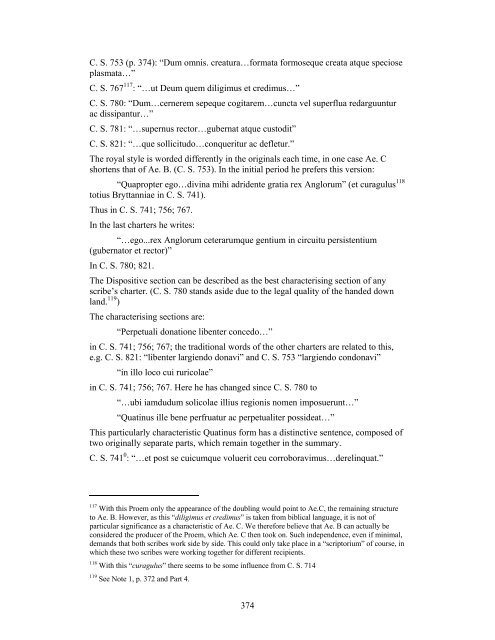Provisional Drogereit pdf
Provisional Drogereit pdf
Provisional Drogereit pdf
Create successful ePaper yourself
Turn your PDF publications into a flip-book with our unique Google optimized e-Paper software.
C. S. 753 (p. 374): “Dum omnis. creatura…formata formoseque creata atque speciose<br />
plasmata…”<br />
C. S. 767 117 : “…ut Deum quem diligimus et credimus…”<br />
C. S. 780: “Dum…cernerem sepeque cogitarem…cuncta vel superflua redarguuntur<br />
ac dissipantur…”<br />
C. S. 781: “…supernus rector…gubernat atque custodit”<br />
C. S. 821: “…que sollicitudo…conqueritur ac defletur.”<br />
The royal style is worded differently in the originals each time, in one case Ae. C<br />
shortens that of Ae. B. (C. S. 753). In the initial period he prefers this version:<br />
“Quapropter ego…divina mihi adridente gratia rex Anglorum” (et curagulus 118<br />
totius Bryttanniae in C. S. 741).<br />
Thus in C. S. 741; 756; 767.<br />
In the last charters he writes:<br />
“…ego...rex Anglorum ceterarumque gentium in circuitu persistentium<br />
(gubernator et rector)”<br />
In C. S. 780; 821.<br />
The Dispositive section can be described as the best characterising section of any<br />
scribe’s charter. (C. S. 780 stands aside due to the legal quality of the handed down<br />
land. 119 )<br />
The characterising sections are:<br />
“Perpetuali donatione libenter concedo…”<br />
in C. S. 741; 756; 767; the traditional words of the other charters are related to this,<br />
e.g. C. S. 821: “libenter largiendo donavi” and C. S. 753 “largiendo condonavi”<br />
“in illo loco cui ruricolae”<br />
in C. S. 741; 756; 767. Here he has changed since C. S. 780 to<br />
“…ubi iamdudum solicolae illius regionis nomen imposuerunt…”<br />
“Quatinus ille bene perfruatur ac perpetualiter possideat…”<br />
This particularly characteristic Quatinus form has a distinctive sentence, composed of<br />
two originally separate parts, which remain together in the summary.<br />
C. S. 741 0 : “…et post se cuicumque voluerit ceu corroboravimus…derelinquat.”<br />
117 With this Proem only the appearance of the doubling would point to Ae.C, the remaining structure<br />
to Ae. B. However, as this “diligimus et credimus” is taken from biblical language, it is not of<br />
particular significance as a characteristic of Ae. C. We therefore believe that Ae. B can actually be<br />
considered the producer of the Proem, which Ae. C then took on. Such independence, even if minimal,<br />
demands that both scribes work side by side. This could only take place in a “scriptorium” of course, in<br />
which these two scribes were working together for different recipients.<br />
118 With this “curagulus” there seems to be some influence from C. S. 714<br />
119 See Note 1, p. 372 and Part 4.<br />
374
















